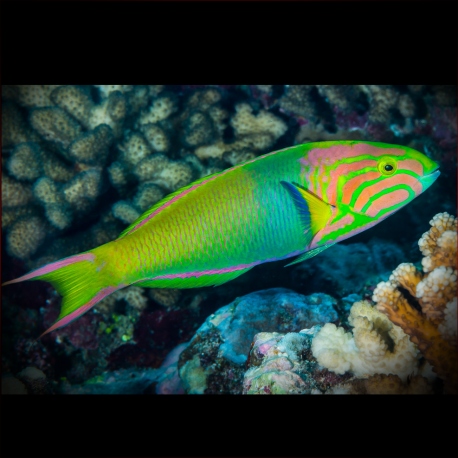More info
Datasheet
| Minimum Tank Size | 1000 litres / 264.17 US gallons |
| Maximum Size | 30.0cm / 11.81inches |
| Reef Compatible | Reef safe with caution |
| Temperament | Aggressive towards other species |
| Temperature | 22.2°C / 71.96°F - 25.6°C / 78.08°F |
| Specific Gravity | 1.020-1.025 |
| Carbonate Hardness | 8-12 |
| pH | 8.1-8.4 |
General Description:
The Yellow-brown wrasse, known scientifically as Thalassoma lutescens, is a striking species that boasts beauty both as juveniles and adults, although their appearance undergoes significant changes as they mature. These fish are known for growing rapidly and can outgrow most home aquaria, making them commonly available for sale. Their diet ranges from small crustaceans and snails to sea urchins, and they possess the ability to crush larger crustaceans against rocks to consume them. Yellow-brown wrasses are highly active fish that require frequent feeding, typically three times a day, and plenty of swimming space due to their active nature. While they may dig themselves into sand, a sandy substrate is not a strict requirement for their well-being.
Aquarium Suitability:
The Yellow-brown wrasse is suitable for aquariums with caution, given their aggressive nature towards other fish species, particularly smaller ones. They are known to pose a threat to small fishes and invertebrates such as crustaceans, snails, and sea urchins. These wrasses demand a very large aquarium when fully grown, often exceeding the typical size limits of home aquariums. Additionally, they have a tendency to jump out of open aquaria, emphasizing the need for secure tank lids when housing them.
Care and Hardiness:
This species falls under the category of Labridae and is recognized for its hardy nature. Yellow-brown wrasses thrive on a varied diet that includes larger crustaceans, other invertebrates, small crustaceans, and zooplankton. They require frequent feeding, especially upon initial introduction to a new tank, although their feeding frequency can decrease when they can locate their natural food sources within the aquarium.
Reef Suitability:
Reef compatibility with this species is feasible with caution, as the Yellow-brown wrasse is considered reef-safe but may exhibit aggressive behavior towards other tank inhabitants, especially small invertebrates often found in reef environments.
Aquarium Setup:
When setting up an aquarium for Yellow-brown wrasses, it is essential to provide ample space for swimming due to their active behavior. The tank should include plenty of hiding places such as live rocks to accommodate their need for security. Maintaining a varied diet for these wrasses is crucial to their overall health and well-being in a captive environment.
Behaviour:
Yellow-brown wrasses exhibit aggressive behavior towards other fish species, particularly smaller and more docile ones. Therefore, it is crucial to exercise caution when housing them with other tank mates. Despite their aggressive tendencies, these wrasses can be somewhat alleviated through regular feeding, a spacious environment, and the presence of ample hiding spots within the aquarium.
Feeding and Diet:
Yellow-brown wrasses thrive on a diet that includes larger crustaceans, other invertebrates, small crustaceans, and zooplankton. This species requires frequent feeding, especially during the initial stages of tank acclimatization, but their dependence on regular meals may decrease as they adapt and locate natural food sources within the tank environment.
Dimorphism:
Yellow-brown wrasses are hermaphroditic, capable of changing gender from female to male as needed. This feature ensures that the population can adapt to its social structure by adjusting the sex composition within the group.
Habitat and Distribution:
These wrasses are found in various regions across the globe, including the East Indian Ocean, West Indian Ocean, Australia, Japan, the Red Sea, Indonesia, the East Pacific, and the Central/West Pacific. Their widespread distribution highlights their adaptability to diverse marine environments and conditions.

